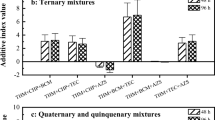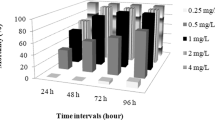Abstract
Due to the increase in the use of phytosanitary products during the last few decades, the importance to study the effect of pesticide mixtures has been established. In this study, we investigated the acute toxicity of two model insecticides, chlordecone (CLD) and pyriproxyfen (PXF), alone and in mixtures, in the estuarine copepod Eurytemora affinis. After 48 h of exposure, the relative LC50 were 73.24 and 131.61 μg/L for PXF and CLD, respectively. The lower concentration tested (10 μg/L) did not affect the mortality of E. affinis whatever the considered chemical compound. To understand the interaction between compounds in mixture, the results were fitted to the concentration addition, Vølund, and Hewlett models. The best fit was obtained with the Hewlett model, suggesting a synergistic effect of the mixture.




Similar content being viewed by others
References
Allan JD, Daniels RE (1982) Life table evaluation of chronic exposure of Eurytemora affinis (Copepoda) to Kepone. Mar Biol 66:179–184
Andersen ME, Dennison JE (2004) Mechanistic approaches for mixture risk assessments—present capabilities with simple mixtures and future directions. Environ Toxicol Pharmacol 16:1–11
Aronstam RS, Hong J-S (1986) Interactions of chlordecone (Kepone) and mirex with the nicotinic acetylcholine receptor - ion channel complex. Toxicol Lett 30:247–251
Baldacchino F, Caputo B, Chandre F, Drago A, Torre A, Montarsi F et al (2015) Control methods against invasive Aedes mosquitoes in Europe: a review. Pest Manag Sci 71:1471–1485
Belden JB, Gilliom RH, Lydy MJ (2007) How well can we predict the toxicity of pesticide mixtures to aquatic life ? Integr Environ Assess Manag 3:364–372
Bollmohr S, Schulz R, Hahn T (2009) Interactive effect of salinity decrease, salinity adaptation, and chlorpyrifos exposure on an estuarine harpacticoid copepod, Mesochra parva, in South Africa. Ecotoxicol Environ Saf 72:756–764
Brown MD, Thomas D, Watson K, Greenwood JG, Kay BH (1996) Acute toxicity of selected pesticides to the estuarine shrimp Leander tenuicornis (Decapoda: Palaemonidae). J Am Mosq Control Assoc 12:721–724
Cabidoche Y-M, Achard R, Cattan P, Clermont-Dauphin C, Massat F, Sansoulet J (2009) Long-term pollution by chlordecone of tropical volcanic soils in the French West-Indies; a simple leaching model accounts for current residue. Environ Pollut 157:1697–1705
Cailleaud K, Budzinski H, Lardy S, Augagneur S, Barka S, Souissi S, Forget-Leray J (2011) Uptake and elimination, and effect of estrogen-like contaminants in estuarine copepods: an experimental study. Environ Sci Pollut Res 18:226–236
Cedergreen N (2014) Quantifying synergy: a systematic review of mixture toxicity studies within environmental toxicology. PLoS One 9 e96580
Coat S, Monti D, Legendre P, Bouchon C, Massat F, Lepoint G (2011) Organochlorine pollution in tropical rivers (Guadeloupe): role of ecological factors in food web bioaccumulation. Environ Pollut 159:1692–1701
Colborn T, vom Seel FS, Soto AM (1993) Developmental effects of endocrine disrupting chemicals in wildlife and humans. Environ Health Perspect 101:378–384
Darriet F, Corbel V (2006) Laboratory evaluation of pyriproxyfen and spinosad, alone and in combination, against Aedes aegypti larvae. J Med Entomol 43
Darriet F, Marcombe S, Etienne M, Yébakima A, Agnew P, Yp-Tcha M-M, Corbel V (2010) Field evaluation of pyriproxyfen and spinosad mixture for the control of insecticide resistant Aedes aegypti in Martinique (French West Indies). Parasit Vectors 3:88
Devreker D, Souissi S, Winkler G, Forget-Leray J, Leboulenger F (2009) Effects of salinity, temperature and individual variability on the reproduction of Eurytemora affinis (Copepoda; Calanoida) from the Seine estuary: a laboratory study. J Exp Mar Biol Ecol 368:113–123
Forget-Leray J, Landriau I, Minier C, Leboulenger F (2005) Impact of endocrine toxicants on survival, development, and reproduction of the estuarine copepod Eurytemora affinis (Poppe). Ecotoxicol Environ Saf 60:288–294
Forget J, Pavillon JF, Beliaeff B, Bocquené G (1999) Joint action of pollutant combinations (pesticides and metals) on survival (LC50 values) and acetylcholinesterase activity of Trigriopus brevicornis (copepoda, harpacticoida). Environ Toxicol Chem 18:912–918
Forget J, Livet S, Leboulenger F (2002) Partial purification and characterization of acetylcholinesterase (AChE) from the estuarine copepod Eurytemora affinis (Poppe). Comp Biochem Physiol Part C: Toxicol Pharmacol 132:85–92
Gourmelon A, Ahtiainen J (2007) Developing test guidelines on invertebrate development and reproduction for the assessment of chemicals, including potential endocrine active substances—the OECD perspective. Ecotoxicology 16:161–167
Guo F, Wang L, Wang W-X (2012) Acute and chronic toxicity of polychlorinated biphenyl 126 to Tigriopus japonicus: effects on survival, growth, reproduction, and intrinsic rate of population growth. Environ Toxicol Chem 31:639–645
Hall LW, Ziegenfuss MC, Anderson RD, Spittler TD, Leichtweis HC (1994) Influence of salinity on atrazine toxicity to a Chesapeake Bay copepod (Eurytemora affinis) and fish (Cyprinodon variegatus). Estuaries 17:181–185
Holmstrup M, Bindesbøl AM, Oostingh GJ, Duschl A, Scheil V, Köhler HR, Loureiro S, Soares AMVM, Ferreira ALG, Kienle C, Gerhardt A, Laskowski R, Kramarz PE, Bayley M, Svendsen C, Spurgeon DJ (2010) Interactions between effects of environmental chemicals and natural stressors: a review. Sci Total Environ 408(18):3746–3762
Hua J, Relyea R (2014) Chemical cocktails in aquatic systems: pesticide effects on the response and recovery of >20 animal taxa. Environ Pollut 189:18–26
ISO14669 (1999): ISO 14669. Water quality—determination of acute lethal toxicity to marine copepods (Copepod, Crustacea). Reviewed in 2010, Geneva, Switzerland
Kortenkamp A (2007) Ten years of mixing coktails: a review of combination effects of endocrine-disrupting chemicals. Environ Health Perspect Suppl 1:98–105
Kulkarni D, Gergs A, Hommen U, Ratte HT, Preuss TG (2013) A plea for the use of copepods in freshwater ecotoxicology. Environ Sci Pollut Res 20:75–85
Kwok KWK, Leung KMY (2005) Toxicity of antifouling biocides to the intertidal harpacticoid copepod Tigriopus japonicus (Crustacea, copepoda): effects of temperature and salinity. Mar Pollut Bull 51:830–837
LeBlanc GA (2007) Crustacean endocrine toxicology: a review. Ecotoxicology 16:61–81
Lee KW, Raisuddin S, Hwang DS, Park HG, Lee JS (2007) Acute toxicities of trace metals and common xenobiotics to the marine copepod Tigriopus japonicus: evaluation of its use as a benchmark species for routine ecotoxicity tests in western Pacific coastal regions. Environ Toxicol 22:532–538
Lesueur T, Boulangé-Lecomte C, Restoux G, Deloffre J, Xuereb B, Le Menach K, Marie S, Petit F, Forget-Leray J (2015) Toxicity of sediment-bound pollutants in the seine estuary, France, using a Eurytemora affinis larval bioassay. Ecotoxicol Environ Saf 113:169–175
Luellen DR, Vadas GG, Unger MA (2006) Kepone in James River fish: 1976–2002. Sci Total Environ 358:286–297
Malaj E, von der Ohe PC, Grote M, Kuhne R, Mondy CP, Usseglio-Polatera P, Brack W, Schafer RB (2014) Organic chemicals jeopardize the health of freshwater ecosystems on the continental scale. Proc Natl Acad Sci 111:9549–9554
McLusky DS, Bryant V, Cambell R (1986) The effects of temperature and salinity on the toxicity of heavy metals to marine and estuarine invertebrates. Oceanogr Mar Biol Annu Rev 24:481–520
Medina P, Smagghe G, Budia F, del Estal P, Tirry L, Viñuela E (2002) Significance of penetration, excretion, and transovarial uptake to toxicity of three insect growth regulators in predatory lacewing adults. Arch Insect Biochem Physiol 51:91–101
Meng Y, Zou E (2009) Impacts of molt-inhibiting organochlorine compounds on epidermal ecdysteroid signaling in the fiddler crab, Uca pugilator, in vitro. Comp Biochem Physiol Part C: Toxicol Pharmacol 150:436–441
Muir D, Lohmann R (2013) Water as a new matrix for global assessment of hydrophilic POPs. TrAC Trends Anal Chem 46:162–172
Okubo T, Yokoyama Y, Kano K, Soya Y, Kano I (2004) Estimation of estrogenic and antiestrogenic activities of selected pesticides by MCF-7 cell proliferation assay. Arch of Environ Contamin Toxicol 46:445–453
Olmstead AW, LeBlanc GA (2003) Insecticidal juvenile hormone analogs stimulate the production of male offspring in the crustacean Daphnia magna. Environ Health Perspect 111:919–924
Pereira VM, Bortolotto JW, Kist LW, Azevedo MB, Fritsch RS, Oliveira RL, Pereira TCB, Bonan CD, Vianna MR, Bogo MR (2012) Endosulfan exposure inhibits brain AChE activity and impairs swimming performance in adult zebrafish (Danio rerio). Neurotoxicology 33:469–475
Pisa LW, Amaral-Rogers V, Belzunces LP, Bonmatin JM, Downs CA, Goulson D, Kreutzweiser DP, Krupke C, Liess M, McField M, Morrissey CA, Noome DA, Settele J, Simon-Delso N, Stark JD, Van der Sluijs JP, Van Dyck H, Wiemers M (2015) Effects of neonicotinoids and fipronil on non-target invertebrates. Environ Sci Pollut Res 22:68–102
Raisuddin S, Kwok KWH, Leung KMY, Schlenk D, Lee J-S (2007) The copepod Tigriopus: a promising marine model organism for ecotoxicology and environmental genomics. Aquat Toxicol 83:161–173
Ritz C, Streibig JC (2014) From additivity to synergism—a modelling perspective. Synergy 1:22–29
Sánchez-Bayo F (2006) Comparative acute toxicity of organic pollutants and reference values for crustaceans. I. Branchiopoda, Copepoda and Ostracoda. Environ Pollut 139:385–420
Sánchez-Bayo F (2012) Insecticides mode of action in relation to their toxicity to non-target organisms. J Environ Anal Toxicol s4:002. doi:10.4172/2161-0525.S4-002
Sanders HO, Huckins J, Johnson BT, Skaar D (1981) Biological effects of Kepone and Mirex in freshwater invertebrates. Environ Contam. Toxicol 10:531–539
Schimmel (1977) Acute toxicity of Kepone to four estuarine animals. Chesap Sci 18
Srivastava AK, Srivastava AK (1994) Effects of chlordecone on the gonads of freshwater catfish, Heteropneustes fossilis. Bull Environ Contam Toxicol 53:186–191
Staton JL, Schizas NV, Klosterhaus SL, Griffitt RJ, Chandler GT, Coull BC (2002) Effect of salinity variation and pesticide exposure on an estuarine har- pacticoid copepod, Microarthridion littorale (Poppe), in the southeastern US. J Exp Mar Biol Ecol 278:101–110
Sullivan JJ, Goh KS (2008) Environmental fate and properties of pyriproxyfen. J Pest Sci 33:339–350
Syberg K, Jensen TS, Cedergreen N, Rank J (2009) On the use of mixture toxicity assessment in REACH and the water framework directive: a review. Hum Ecol Risk Assess 15:1257–1272
Theede H, Scholz N, Fischer H (1979) Temperature and salinity effects on the acute toxicity of cadmium to Laomedea loveni (hydrozoa)*. Mar Ecol Prog Ser 1:13–19
Tuberty SR, Mckenney CL (2005) Ecdysteroid responses of estuarine crustaceans exposed through complete larval development to juvenile hormone agonist insecticides. Integr Comp Biol 45:106–117
WHO (2006) Pesticides and their application for the control of vectors and pests of public health importance WHO/CDS/NTD/WHOPES/GCDPP/2006.1viii, 114 p. Geneva: World Health Organization
Woignier T, Clostre F, Macarie H, Jannoyer M (2012) Chlordecone retention in the fractal structure of volcanic clay. J Hazard Mater 241–242:224–230
Acknowledgments
The present study was a part of the research project CREOLE (number EST/2011/1/190) supported by the French Agency for food, environmental and occupational health safety (ANSES, France) under its “Programme National de Recherche Environnement-Santé-Travail (PNR EST)”. We thank A. Berred for his interest and help in this work. Elena Legrand was the recipient of a doctoral fellowship from the “Région Haute-Normandie.”
Author information
Authors and Affiliations
Corresponding author
Additional information
Responsible editor: Philippe Garrigues
Rights and permissions
About this article
Cite this article
Legrand, E., Boulangé-Lecomte, C., Restoux, G. et al. Individual and mixture acute toxicity of model pesticides chlordecone and pyriproxyfen in the estuarine copepod Eurytemora affinis . Environ Sci Pollut Res 24, 5976–5984 (2017). https://doi.org/10.1007/s11356-016-8294-5
Received:
Accepted:
Published:
Issue Date:
DOI: https://doi.org/10.1007/s11356-016-8294-5




